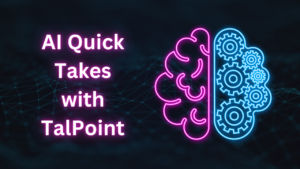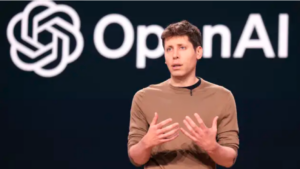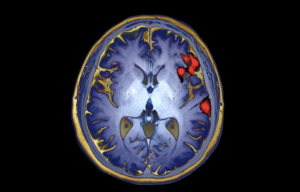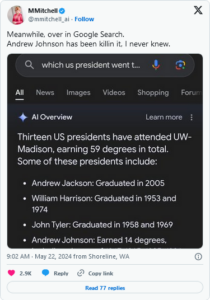Published: May 31, 2024
AI Quick Takes with TalPoint – Week of May 27
By TalPoint Marketing weekly wrap up

Your weekly source for news and updates on all things AI.
Looking for more regular updates from TalPoint? Follow us on Linkedin, Twitter, or visit us at TalPoint.com.
Read time: under 4 minutes
AI Spotlight

OpenAI’s Safety and Security Committee
Formation and Role of the Safety and Security Committee
OpenAI has set up a new Safety and Security Committee led by CEO Sam Altman, Bret Taylor, Adam D’Angelo, and Nicole Seligman. This committee will recommend “critical safety and security decisions for OpenAI projects and operations” to the board. Over the next 90 days, they will evaluate OpenAI’s processes and safeguards, then share their recommendations.
Transition to a Commercial Entity
The committee’s formation signifies OpenAI’s shift from a non-profit-like entity to a commercial one. This change aims to streamline product development while maintaining accountability. This follows the disbanding of the previous oversight team and the departure of key figures like Ilya Sutskever and Jan Leike. Leike pointed out that OpenAI’s “safety culture and processes have taken a backseat to shiny products.”
Addressing AI Safety Concerns
The board’s decision to form this new committee comes amid ongoing debates about AI safety and regulation. The current board, led by former Salesforce co-CEO Bret Taylor, countered allegations from former board members Helen Toner and Tasha McCauley that Sam Altman’s ouster was due to safety concerns. They stated, “In six months of nearly daily contact with the company, we have found Altman highly forthcoming on all relevant issues and consistently collegial with his management team.”
Development and Implementation of Safety Practices
The committee will consult with experts like Rob Joyce and John Carlin to ensure robust safety and security measures as OpenAI advances its AI models. The new model is expected to bring OpenAI “to the next level of capabilities on our path to AGI,” or artificial general intelligence, which aims to be as smart or smarter than humans.
Despite these efforts, OpenAI faces significant criticism. Former board members Toner and McCauley argue that OpenAI’s safety culture has taken a backseat to product development, casting doubt on the effectiveness of OpenAI’s self-governance and commitment to safety. This highlights the ongoing tension between innovation and safety within the company.
Trending AI Technologies

Breakthrough in Bilingual Communication for Stroke Survivors
Scientists at the University of California – San Francisco have developed a bilingual brain implant that allows a stroke survivor to communicate in both Spanish and English for the first time. This system, described in Nature Biomedical Engineering, uses AI to decode brain activity into sentences displayed on a screen. The participant, known as Pancho, became severely paralyzed due to a stroke at age 20 and can now communicate effectively despite his paralysis.
Development and Functionality of the AI System
Under the leadership of Dr. Edward Chang, the research team at the Center for Neural Engineering and Prostheses designed a neural implant that records Pancho’s brain activity as he attempts to speak. The AI system, trained using neural networks, decodes this activity into words and phrases. Initially, the implant restored communication only in English, but further development allowed it to function bilingually. The AI distinguishes between languages with 88% accuracy and decodes sentences correctly 75% of the time, enabling Pancho to hold unscripted conversations.
Insights into Brain’s Language Processing and Future Research
The research revealed that Pancho’s brain processed both languages in the same cortical area, challenging previous beliefs that different languages activate distinct brain regions. This finding allowed the scientists to use transfer learning to train the bilingual system more efficiently. The study demonstrates the feasibility of a bilingual speech neuroprosthesis and suggests that this technology could restore more natural communication for bilingual speakers with paralysis. Future research will explore the system’s application to languages with different articulatory properties and improve its ability to switch between languages seamlessly.
AI Data Point

Global revenue from AI semiconductors is projected to reach $71 billion in 2024, marking a 33% increase from 2023, according to Gartner’s latest forecast. “Currently, generative AI is driving the demand for high-performance AI chips in data centers. In 2024, AI accelerators in servers, which handle data processing tasks typically performed by microprocessors, will be valued at $21 billion, growing to $33 billion by 2028,” stated Alan Priestley, VP Analyst at Gartner.
Gartner predicts that AI-enabled PCs will constitute 22% of total PC shipments in 2024. By the end of 2026, all enterprise PC purchases will be AI-enabled. These AI PCs feature a neural processing unit (NPU) that allows for longer, quieter, and cooler operation, with AI tasks running continuously in the background, creating new opportunities for leveraging AI in everyday activities. Although AI semiconductor revenue is expected to maintain double-digit growth throughout the forecast period, 2024 will see the highest growth rate (see Table 1).
Company Watch

Google’s new AI Overviews feature has been criticized for generating wildly incorrect answers to search queries. An infamous example includes advising a user to use glue on pizza to keep the cheese from sliding off. According to an interview with Sundar Pichai, the CEO of Google, these errors, referred to as “hallucinations,” are an inherent feature of AI LLMs and remain an unsolved problem. Despite efforts by Google engineers to address these issues, the AI Overviews continue to produce bizarre errors, such as claiming that 13 American presidents graduated from the University of Wisconsin-Madison. Pichai acknowledges the inaccuracies but emphasizes the overall utility of the feature. He asserts that while the AI will sometimes get things wrong, the team is making progress on improving factual accuracy year over year.

However, the persistent errors have led to public backlash and concern over the reliability of Google’s search results. AI consultant and SEO expert Britney Muller commented that people often expect AI to be much more accurate than traditional methods, which it frequently isn’t. This has raised questions about Google’s strategy, especially as it competes with other AI platforms like Perplexity and OpenAI. Pichai’s remarks suggest that both Google and the wider internet community may face ongoing challenges as they navigate the evolving landscape of AI technology.
Practical AI
![]()
PhotoPacks: Say goodbye to costly photo sessions and hello to PhotoPacks, the tool that gives you great, studio-quality headshots fast. This tool creates images that are all you, letting your unique style come through.
———————————————————————————————————————————————————————————————————————————————————————————-
Thanks for reading. Until next weekend!
For questions and feedback, email us at marketing@talpoint.com. We would love to hear from you.




